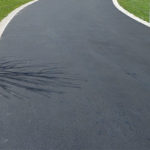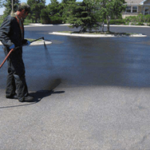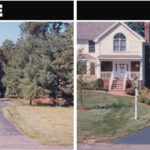How to apply Driveway Sealer
 Driveway from asphalt can stand for 20-30 years with proper maintenance and it needs to be protected and sealed against the external condition such as weight pressure and climate. The reason why we need to seal asphalt driveways, as water permeates cracks in the material and settles down at the base, the strength of the base is compromised, resulting in the formation of potholes. Cracks filled with water are also an open invitation to further damage. In addition to that, grass can begin to grow up through cracks on the edges of the surface. Damage from ultraviolet rays and oil or gas spills are other good reasons for sealing asphalt driveways.
Driveway from asphalt can stand for 20-30 years with proper maintenance and it needs to be protected and sealed against the external condition such as weight pressure and climate. The reason why we need to seal asphalt driveways, as water permeates cracks in the material and settles down at the base, the strength of the base is compromised, resulting in the formation of potholes. Cracks filled with water are also an open invitation to further damage. In addition to that, grass can begin to grow up through cracks on the edges of the surface. Damage from ultraviolet rays and oil or gas spills are other good reasons for sealing asphalt driveways.
Sealing asphalt driveways is not very difficult. It does, however, require about two hours of work time for every 20 feet that need to cover, not counting drying time (or also known as “curing” time).
Before starting the project, herewith some tools and supplies that will be needed:
• Push broom, stiff-bristled brush
• Optional: pressure washer
• Garden hose with spray nozzle
• Application brush
• Asphalt driveway sealer (sealant)
• GlovesS
• Patching compounds, if needed
• Detergent to remove oil/gas stains, if needed
Step to apply Driveway Sealer
Here with the steps needed to seal asphalt driveways
1. When planning for sealing asphalt driveways (also known as “hot top” or “blacktop”), wait till the ground temperature is 45 degrees Fahrenheit or greater and no rain is expected for three days.
2. Much of the work in sealing asphalt driveways is in the preparation. It is also necessary to prepare physical strength to do the job. One note that, asphalt driveway sealers are rather unpleasant products, so avoid skin contact with them by dressing properly. Also, avoid inhaling the vapors given off by asphalt driveway sealers (sealants).
3. Grass overhanging the edges of the surface should be removed. With a stiff-bristled brush clean any oil or gas stains using a detergent specially made for this purpose, which can be found at auto supply stores. Sweep the surface clean with a push broom. Patching compounds are available at home improvement centers to fill in large cracks or depressions; if the surface is plagued with either, fill them in before continuing with Step 4. Follow label directions for drying time for these compounds.
4. With the garden hose, hose down the surface with a vigorous spray to remove dirt missed in the sweeping process. A pressure washer would make this job easier and more effective but is optional. Allow the surface to dry.
5. Well before prying off the lid of the tub of asphalt driveway sealer, turn it upside down. This will pre-mix the contents. Once the tub is opened, continue to stir periodically so that the sealant remains well mixed.
6. Beginning in one corner, pour some of the asphalt driveway sealers on the surface. In general, it is easiest to work on one small square section at a time (a section, say, 10-20 feet square), rather than doing long narrow strips. Apply sealant in thin, overlapping coats with a long-handled application brush or squeegee.
7. Drying time is a minimum of 24 hours, and it is highly recommended not allowing traffic of any kind on the surface, but especially automobile traffic. Leave barrels at the entrance to the yard to forbid vehicular access, or simply use the empty sealer tubs. For greater visibility, drive a post into the ground on either side of the entrance, and string some yellow construction tape between the posts.
Some helpful tips for this project are as follows. It is worth to remember that putting on a thicker layer of sealant will not provide additional protection. It is advisable to avoid the “more is better” pitfall and follow the manufacturer’s instructions.
Additional important note on the project, that it is not a one time job. Asphalt driveway sealer should be applied within six months of installation, and then again every one to three years thereafter. However, a sealant should not be applied immediately after installation, as the hot top must cure for 30 days. In areas with harsh winters, sealing asphalt driveways once per year may be desirable, but beware the slick surface that will result.
Contact us
 Phone Call |
 Text Message |
 |







